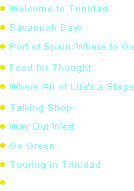


 rinidad is an island that can leave your head spinning. This is not your run-of-the-mill Caribbean destination, with a few
rinidad is an island that can leave your head spinning. This is not your run-of-the-mill Caribbean destination, with a few

|
| Photo: Nort/South Intersection: Mark Lyndersay |
Walk down any city street, and you’ll see facial features from Africa and China, India, Europe and the Middle East, and an infinite random mix of them all. The faces of Trinidad bespeak a history of conquest and colonialism, reconciliation and integration: a meltdown of peoples and cultures and languages (which, in the process, produced a fair share of international beauty queens). Archbishop Desmond Tutu called this “rainbow country”.
Look around: you’ll find Muslim mosques and Hindu temples, Christian cathedrals and Evangelical “crusade” marquees. Have a meal: curry or creole, Chinese or Lebanese, Indian or Italian. Take in some music: steelband, tassa, soca, chutney, rapso. Everywhere you go, anything you do, is infused with the rich syncretic realities of this fascinating land.
A drive through the countryside will take you through fields of cane, their feathery arrows luminous in the sun; or to a saltwater swamp where alligators amble on the muddy banks and scarlet birds flock in by the hundreds at sunset, turning their roosting-trees red; to a lake made of sticky black tar, or a wildfowl sanctuary in the midst of an oil refinery; to a ten-mile-long beach lined with leaning palms, or an islet where monkeys howl hauntingly in the treetops. From rain forest to wetlands, Trinidad is a symphony of different environments, a wonderland for today’s eco-tourist.
But this is not a wilderness island: small villages are dotted everywhere, and in the major cities, sophistication reigns. Port of Spain, the capital, is one of the major commercial centres of the Caribbean, with advanced telecommunications and international links. In the south, San Fernando is the engine-room of the industrial heartland, servicing the extensive oil and gas industries that provide much of the country’s wealth. And in Central Trinidad, Chaguanas is a hotbed of entrepreneurial activity, as well as being the hub of the sugar cane economy. A wealth of restaurants, shopping and entertainment make these urban communities dynamic places to explore.
Trinidad is not a place for sitting back and doing nothing: this is an island that demands to be discovered. But, at the end
of it all, if you know where to find them — yes: there are beaches, and sand, and sunsets second to none. Even casinos.
Donna Yawching
e-mail comments and questions to
webmaster@carib-link.net
This Page Is Maintained By Carib-Link Web Designers
(c) 1998 Media and Editorial Projects. All rights reserved.